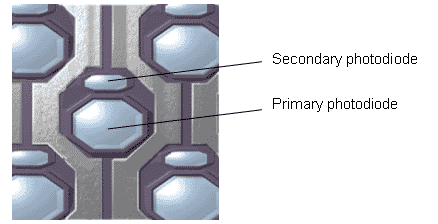Fuji adds further innovations to its Super CCD | |||
By Ian Burley | |||
Official Fujifilm press release on the new Super CCD SR:Introducing ‘High Fidelity Photography™’ Fujifilm unveils Super CCD SR technology for new generation of digital cameras 22 January 2003 Fuji Photo Film (UK) Ltd today announced a major innovation in digital photography. Already positioned at the vanguard of the photographic industry with its ground-breaking Third Generation (3G) Super CCD, Fujifilm has upped the digital stakes with the launch of Super CCD SR, part of the company’s Fourth Generation of Super CCDs. Until now, discussions surrounding digital imaging technology have concentrated simply on the number of megapixels provided by manufacturers’ cameras. Fujifilm is now refocusing these discussions on the issue of the level of detail that can be captured, with the introduction of this new Super CCD. Fujifilm’s Super CCD SR will provide a truer representation of the actual subject being photographed, revealing highlight detail and increased dynamic range, and resulting in stunningly detailed images – particularly in dark and highlight areas. Fujifilm has dubbed this advance ‘High Fidelity Photography™’, a reference to the sensor’s extraordinarily accurate rendition of detail – very similar in principle to the technology advances that led to the development of audio ‘hi-fis’. Where once a single photodiode* was responsible for capturing the full range of light strengths at a single location on the sensor, Fujifilm has now paired two photodiodes per photosite**: a larger, primary photodiode adjusted for high sensitivity, with the secondary photodiode for lower sensitivity. When combined, they offer four times the dynamic range† of conventional photodiodes.Adrian Clarke, Director of Consumer Products, Fuji Photo Film (UK) Ltd, said, “We’re hoping that people will look back at this day as a turning point in digital photography – a point when people stop asking merely how many pixels there are, and start to question what those pixels actually do.”Anyone who photographs in a range of conditions – whether it’s a sunny day, a sky with clouds, while using a flash, or any bright object – will benefit from the Fujifilm Super CCD SR. The core benefits of the technology are:
An explanation of Super CCD SR Super CCD SR uses a new CCD arrangement, based on the advanced octagonal sensor arrangement that Fujifilm pioneered with 3G Super CCD, but taking the concept even further with a ‘double honeycomb’ shaped photodiode structure. Not one, but two photodiodes capture information on the same area of the image. The sensitive primary photodiode registers the main volume of light reflected off the subject (similar to a conventional Super CCD photodiode), whilst the secondary photodiode captures highlight information from the same part of the image. Because it is set at a lower sensitivity than the primary photodiode (in other words, records a darker image), the secondary photodiode is able to ‘see’ additional detail in bright areas that is beyond the reach of conventional photodiodes. Schematic of Super CCD SR (double honeycomb structure) sensor layout:
This combination of primary and secondary photodiodes produces an image that is more richly detailed than conventional CCDs, resolving more detail in highlight and dark areas of the image. With three million photodiode pairs in three million photosites on the entire sensor, the camera’s LSI algorithms then calculate the intermediary values, giving a file output of six million pixels***. With six million photodiodes and a six million output file, resolution will improve beyond current 3G Super CCD technology, however Fujifilm is keen to stress that it is not a ‘true’ six million pixel CCD. According to Adrian Clarke, “With sophisticated imaging technologies, the real benefits can sometimes be on the obscure side, however this is not the case with Super CCD SR. The user will immediately see better results in bright sunshine, better flash results, improved resolution of objects within bright areas, such as cloud detail within the sky, and finally an increased exposure tolerance in difficult lighting conditions. Every photographer will recognise this as good news.” | |||
| |||
| Feedback | Main news page | Discussion forum | Newsletter | | |||
DPN News service
www.dp-now.com

